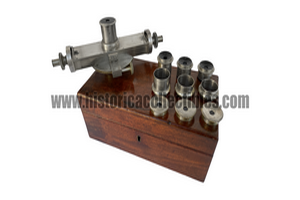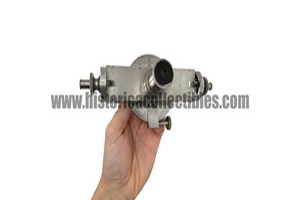Filar Micrometer W. & S. Jones, Belonged to Alfred Henry Fison, 1791/1859
Filar Micrometer for Astronomical Telescope, produced by W. & S. Jones (William & Samuel Jones) in the first decade of 1800, and used by means of a telescope, to calculate the angular distances of celestial stars such as, stars, planets and asteroids.
It is complete with four eyepieces, of which respectively 80, 100, 130 and 180 magnifications, through which observations are possible from relatively closer distances up to much more considerable ones.
The belonging and use of this instrument can be traced back to the famous astronomer Alfred Henry Fison (1857-1923) as, inside the original mahogany box which contains both the instrument and the eyepieces, There is a label which shows, in addition to the name of A. H. Fison, also some handwritten technical notes attributable to the characteristics of the instrument.
During his observations, Fison used this type of instrument very often as he was the proponent of some important publications relating to the calculation of the distance between two stars.
The micrometer is made of brass and externally retains all its silvering, the mechanisms work perfectly, no lack or defects and also its original and very rare "reticular wires" are present inside.
The eyepiece wire micrometer for telescopes is made up of fixed wires parallel and orthogonal to the rotation axis of the telescope, and of mobile wires whose displacements are determined by an accurate micrometric screw. It is an accessory instrument of telescopes used to measure angular distances to celestial objects.
William and Samuel Jones were among the most successful producers of optical-scientific instruments in London in the late 18th and early 19th centuries.
In 1776 John Jones (1736/7-1808) was in business in the Holborn area, trading as an optician, his son William was an apprentice and in 1784 he entered into a partnership with his father.
In 1791 William's brother Samuel joined the company after his father's retirement and they traded under the sign of Archimedes at 135 Holborn near Furnival's Inn.
In 1793 the company drew up the auction catalog for the disposal of the magnificent collection of the third Earl of Bute.
W. & S. Jones published "The Description and Use of a New Portable Orrery" to promote their tools and describe their use.
In 1795–6 the death of another competitor, the young George Adams (son of George Adams), and the subsequent acquisition of George Junior's shares and the copyrights of his books from his wife gave another impetus to the Jones' business.
In 1797 Jones introduced the box sextant or "pocket sextant" for nautical navigation, one of the earliest marvels of mechanical miniaturization.
In 1797-1817 they supplied Harvard college apparatus.
In 1800 they moved across the street no. 30 Holborn. The company was extremely prolific, selling a wide range of optical, philosophical and mathematical instruments and apparatus in the mid-range of price and quality, as detailed in their comprehensive catalogs, published at frequent intervals.
The company continued to trade its products at no. 30 Holborn until Samuel's death in 1859.


